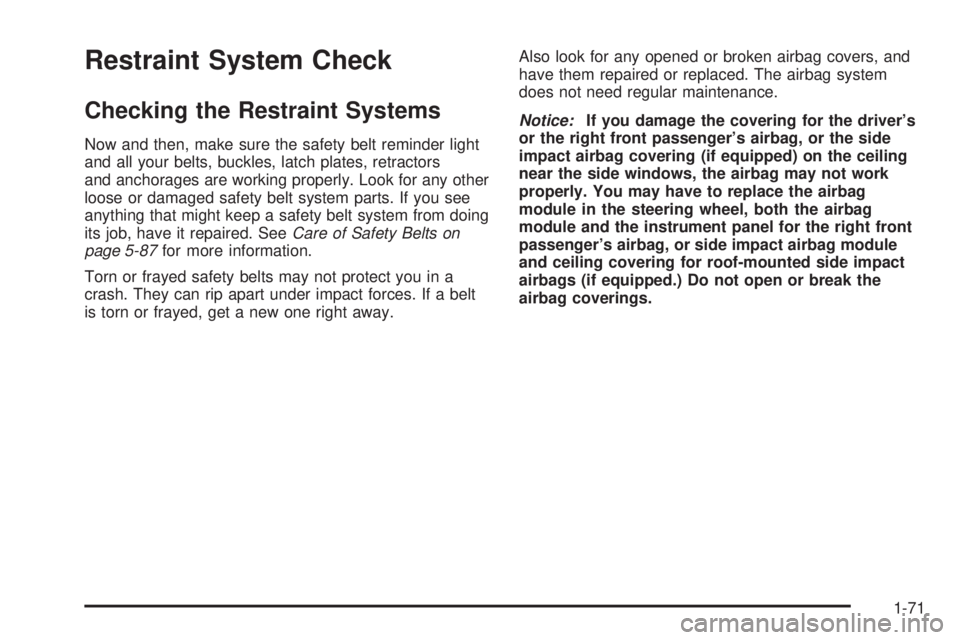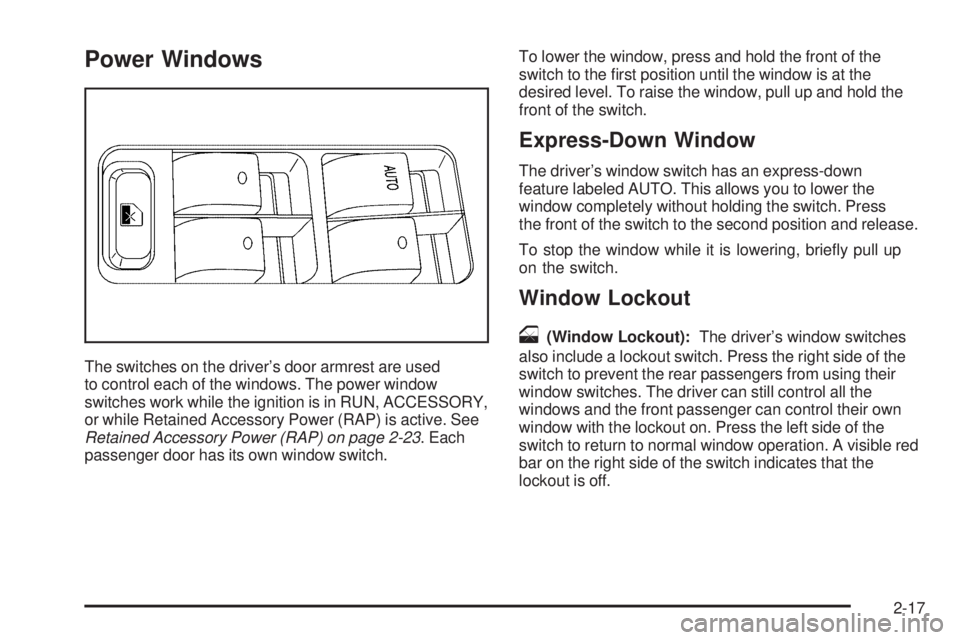2006 BUICK LACROSSE window
[x] Cancel search: windowPage 77 of 444

Restraint System Check
Checking the Restraint Systems
Now and then, make sure the safety belt reminder light
and all your belts, buckles, latch plates, retractors
and anchorages are working properly. Look for any other
loose or damaged safety belt system parts. If you see
anything that might keep a safety belt system from doing
its job, have it repaired. SeeCare of Safety Belts on
page 5-87for more information.
Torn or frayed safety belts may not protect you in a
crash. They can rip apart under impact forces. If a belt
is torn or frayed, get a new one right away.Also look for any opened or broken airbag covers, and
have them repaired or replaced. The airbag system
does not need regular maintenance.
Notice:If you damage the covering for the driver’s
or the right front passenger’s airbag, or the side
impact airbag covering (if equipped) on the ceiling
near the side windows, the airbag may not work
properly. You may have to replace the airbag
module in the steering wheel, both the airbag
module and the instrument panel for the right front
passenger’s airbag, or side impact airbag module
and ceiling covering for roof-mounted side impact
airbags (if equipped.) Do not open or break the
airbag coverings.
1-71
Page 79 of 444

Keys...............................................................2-2
Remote Keyless Entry System.........................2-3
Remote Keyless Entry System Operation...........2-4
Doors and Locks............................................2-10
Door Locks..................................................2-10
Power Door Locks........................................2-11
Delayed Locking...........................................2-11
Automatic Door Lock.....................................2-12
Rear Door Security Locks..............................2-12
Lockout Protection........................................2-13
Trunk..........................................................2-13
Windows........................................................2-16
Power Windows............................................2-17
Sun Visors...................................................2-18
Theft-Deterrent Systems..................................2-18
Content Theft-Deterrent.................................2-18
PASS-Key
®III ..............................................2-20
PASS-Key®III Operation...............................2-21
Starting and Operating
Your Vehicle...............................................2-22
New Vehicle Break-In....................................2-22
Ignition Positions..........................................2-23
Retained Accessory Power (RAP)...................2-23
Starting the Engine.......................................2-24
Engine Coolant Heater..................................2-25
Automatic Transaxle Operation.......................2-26Parking Brake..............................................2-30
Shifting Into Park (P).....................................2-31
Shifting Out of Park (P).................................2-33
Parking Over Things That Burn.......................2-34
Engine Exhaust............................................2-34
Running the Engine While Parked...................2-35
Mirrors...........................................................2-36
Manual Rearview Mirror.................................2-36
Manual Rearview Mirror with OnStar
®..............2-36
Automatic Dimming Rearview Mirror................2-36
Automatic Dimming Rearview Mirror
with OnStar
®............................................2-37
Outside Power Mirrors...................................2-37
Outside Power Heated Mirrors........................2-38
Outside Convex Mirror...................................2-38
OnStar
®System.............................................2-38
Universal Home Remote System......................2-40
Universal Home Remote System Operation......2-41
Storage Areas................................................2-44
Glove Box...................................................2-44
Cupholder(s)................................................2-45
Center Console Storage Area.........................2-46
Convenience Net..........................................2-46
Sunroof.........................................................2-47
Section 2 Features and Controls
2-1
Page 80 of 444

Keys
{CAUTION:
Leaving children in a vehicle with the ignition
key is dangerous for many reasons. They
could operate the power windows or other
controls or even make the vehicle move. The
children or others could be badly injured or
even killed. Do not leave the keys in a vehicle
with children.
2-2
Page 85 of 444

Remote Vehicle Start
Your vehicle may have a remote starting feature. This
feature allows you to start the engine from outside of the
vehicle. It may also start up the vehicle’s heating or air
conditioning systems and rear window defogger. When
the remote start system is active, the climate control
system will heat and cool the inside of the vehicle based
on the outside temperature. The rear window defogger
will be turned on by the climate control system when it is
heating the inside of the vehicle. Normal operation of the
system will return after the key is turned to the RUN
position.
Laws in some communities may restrict the use of remote
starters. For example, some laws may require a person
using remote start to have the vehicle in view when doing
so. Check local regulations for any requirements on
remote starting of vehicles.
Do not use the remote start feature if your vehicle
is low on fuel. Your vehicle may run out of fuel.The remote start feature provides two separate starts
per ignition cycle, each with 10 minutes of engine
running time.
The remote vehicle start feature needs to be reset
after your vehicle’s engine is started two times using
the transmitter’s remote start button. The remote start
system is reset by inserting the vehicle’s key into the
ignition switch and turning it to RUN. SeeIgnition
Positions on page 2-23for information regarding the
ignition positions on your vehicle.
Your remote keyless entry transmitter with the remote
start button provides an increased range of operation.
You can start your vehicle from an average range of
approximately 492 feet (150 m) away. However the
range may be less while the vehicle is running, and as
a result, you may need to be closer to your vehicle to
turn it off than you were to turn it on.
There are other conditions which can affect the
performance of the transmitter, seeRemote Keyless
Entry System on page 2-3for additional information.
2-7
Page 91 of 444

When you want to open a rear door when the security
lock is on, do the following:
1. Unlock the door using the remote keyless entry
transmitter, if equipped, the power door lock
switch, or by lifting the rear door manual lock.
2. Open the door from the outside.
To cancel the rear door security lock, do the following:
1. Unlock the door and open it from the outside.
2. Insert the key into the security lock slot and turn
it so the slot is in the vertical position.
Lockout Protection
The lockout protection feature makes it more difficult
to lock the key in the vehicle. If the driver’s door is open
while the key is in the ignition, the door cannot be locked
with the power door lock switch.
This feature cannot guarantee that you will never be
locked out of the vehicle. If the key is not left in the
ignition, or, if the manual door lock is used, the key
could still be locked inside the vehicle. Always
remember to take the key with you.
Trunk
{CAUTION:
It can be dangerous to drive with the trunk lid
open because carbon monoxide (CO) gas can
come into your vehicle. You cannot see or
smell CO. It can cause unconsciousness and
even death. If you must drive with the trunk lid
open or if electrical wiring or other cable
connections must pass through the seal
between the body and the trunk lid:
Make sure all other windows are shut.
Turn the fan on your heating or cooling
system to its highest speed and select the
control setting that will force outside air
into your vehicle. See Climate Control
System.
If you have air outlets on or under the
instrument panel, open them all the way.
SeeEngine Exhaust on page 2-34.
2-13
Page 94 of 444

Windows
{CAUTION:
Leaving children, helpless adults, or pets in a
vehicle with the windows closed is dangerous.
They can be overcome by the extreme heat
and suffer permanent injuries or even death
from heat stroke. Never leave a child, a
helpless adult, or a pet alone in a vehicle,
especially with the windows closed in warm
or hot weather.
2-16
Page 95 of 444

Power Windows
The switches on the driver’s door armrest are used
to control each of the windows. The power window
switches work while the ignition is in RUN, ACCESSORY,
or while Retained Accessory Power (RAP) is active. See
Retained Accessory Power (RAP) on page 2-23. Each
passenger door has its own window switch.To lower the window, press and hold the front of the
switch to the �rst position until the window is at the
desired level. To raise the window, pull up and hold the
front of the switch.
Express-Down Window
The driver’s window switch has an express-down
feature labeled AUTO. This allows you to lower the
window completely without holding the switch. Press
the front of the switch to the second position and release.
To stop the window while it is lowering, brie�y pull up
on the switch.
Window Lockout
o
(Window Lockout):The driver’s window switches
also include a lockout switch. Press the right side of the
switch to prevent the rear passengers from using their
window switches. The driver can still control all the
windows and the front passenger can control their own
window with the lockout on. Press the left side of the
switch to return to normal window operation. A visible red
bar on the right side of the switch indicates that the
lockout is off.
2-17
Page 96 of 444

Sun Visors
To block out glare, swing down the sun visors. They can
be detached from the center retainer and slid along the
rod to cover different areas of the front window and
rotated to cover the side windows.
Visor Vanity Mirror
Swing down the sun visors and lift the cover to expose
the vanity mirror. Do not drive with the cover lifted due to
possible glare impeding other drivers behind or to the
side of the vehicle.
Theft-Deterrent Systems
Vehicle theft is big business, especially in some cities.
Although your vehicle has a number of theft-deterrent
features, we know that nothing we put on it can make it
impossible to steal.
Content Theft-Deterrent
Your vehicle may have a content theft-deterrent
alarm system.
A red light located on top
of the instrument panel,
toward the center of the
vehicle and near the
windshield, will �ash
slowly when the system
is armed.
The theft-deterrent alarm system needs to be activated
through the Driver Information Center (DIC). See
“CONTENT THEFT” under “Customization Menu Items”
inDIC Vehicle Personalization on page 3-75. While
armed, the doors will not unlock with the power door lock
switch. The remote alarm will sound if someone tampers
with the trunk or enters the vehicle without using the
remote keyless entry transmitter or key to unlock the
doors. The horn will sound and the headlamps will �ash
for up to two minutes. The system will also cut off the fuel
supply, preventing the vehicle from being driven.
2-18